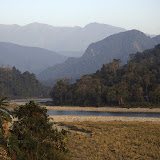 |
| Bhalukpong |
Feb 28 - Shillong to Bhalukpong
- I catch the first “Sumo” (Indian 4x4 used for carrying passengers between population centers) from Shillong to Guwahati. Sumo drivers in northern India all seem to have an excess of testosterone, they all want to drive as fast as possible, but more important, they want to push oncoming traffic off the road. They deliberately drive over the center line in order to take up more than their share of the road. Many times, our driver would inch over to the right causing bicycle, motorcycle, auto, and pedestrian traffic to have to leave the tarmac or risk getting hit. The drivers will also try this with big trucks but very few of the big trucks will play the game. Instead, they expect the sumo drivers to leave the tarmac so they can drive down the center of the tarmac. It annoys me and I have to tell myself not to get excited, it’s just the way it is done here.
- A final comment on driving. I did a quick counting survey in which I counted one hundred trucks on the road. Of these, nine were broken down in some way. Based on qualitative observations over the past few weeks, this 9% breakdown rate seems reasonable. It all combines to give India driving a “wild west” feel. - I meet up with my guide, Bhupen, and driver, Radju and we set off for Arunachal Pradesh, the most protected province in India with strict permit control.
- We stop in the city of Tezpur for lunch. I learn only afterward that there was a bomb blast in the Tezpur market the day before we arrive. First one in three years.
- The road from Jorbat to Tezpur is being upgraded, or should I say UPGRADED. This road in the process of being built looks more like an American superhighway than an Indian Secondary Road. I read in an Indian newspaper that India has become increasingly aware of the build up of Chinese forces on the other side of the border. This new road is almost certainly designed with a Chinese skirmish in mind.
- At one point when our road had become little more than a tarmac track through farmlands (about 30km before the Assam/Arunachal border), a large group of farm workers gathered round our vehicle and would not get out of the way until both Bhupen and the driver had made a “donation”. They were asking me for one as well but I feigned ignorance and they let us proceed without me having to pay a “bribe”.
- Arrived at the Arunachal border at 4PM and due to permit problems, had to spend the night without entering Arunachal. The main hotel in Bhalukpong was full but they managed to find a room in a back building. I peed in the toilet and when I flushed the toilet, nothing happened. I tried other taps in the bathroom and they did not work either. It just added to the charm of the experience. I told Bhupen that I would be happy sleeping outside in my sleeping bag. He seems appalled at the idea. I suppose most of his clients are not quite so tolerant of rustic conditions. I am thriving on it, thinking to myself when I discover that there is no running water in the bathroom, “Yes!” Hotel full, find another hotel, no bed, sleep on floor, no water, intermittent power - this is the real deal. This is how this part of India works.
- The person who was waiting on me in the hotel was so eager to please. When I mentioned that there was no water in the bathroom, he touched his head and ran off to get two buckets of water for me. Similarly when I asked for a an extra chair to use as a table for my laptop, he ran downstairs and came bounding back up with the chair. When the power first went out, he brought a candle and matches to me.
- One of the hotel workers told me that on the other side of the river, there are tigers, lots of tigers. He pointed out a couple of dwellings that were up on stilts, and this was the reason. He said that in 1990, authorities found 10 corpses that had been killed by tigers. They closed off the area and have made it into a wildlife preserve.
- This hotel clearly dates from the British. I expect this was one of their “Hill Stations”, like Darjeeling, where the British gentry would retire to when it became oppressively hot in their constituencies. I feel a bit like British gentry now. I’m sitting on the front porch of the “back rooms” (a separate building from the main hotel, located behind and further from the water than the main building). Various Indians are walking past me into this building and as I greet them with, “Good Evening”, I’m never sure whether it is one of the workers I am addressing or an upper crust Indian here on vacation. However, I am always conscious that the Indians treat me differently than their own. This leads to me feeling different than the Indians, a situation that must change over time. It would be interesting to talk to an old timer and find out whether Indian attitudes have changed since India achieved independence in 1949.
1 comment:
Being different is not necessarily a bad thing, you can feel that way even at home. Cass
Post a Comment